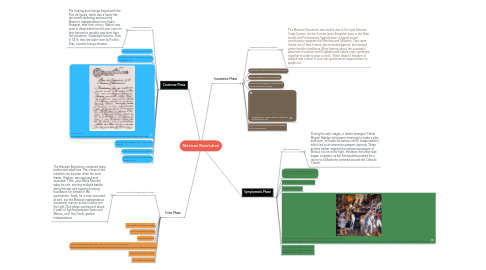
1. Crisis Phase
1.1. Climax of events and beginning of change:
1.1.1. The Mexican Revolution contained many battles and rebellions. The climax of the rebellion can be seen when the main leader, Hidalgo, was captured and executed. Then, Jose Maria Morelos, takes his role, winning multiple battles along the way and creating a strong foundation for himself in the government. Sadly, he is soon executed as well, but the Mexican Independence movement lives on as the Creoles join the fight. This phase consisted of about 6 years of fighting between Spain and Mexico, until they finally gained independence.
1.2. 1811 Battle of Calderon Bridge
1.3. Years of continued fighting
1.4. Castas raid towns
1.5. After Hidalgos execution, Jose Maria Morelos assumes leadership https://upload.wikimedia.org/wikipedia/commons/b/b3/Morelos_por_autor_an%C3%B3nimo.jpg
1.6. 1815 Revolt led by Morelos
1.7. 1815 Battle of Tezmalca
2. Covalence Phase
2.1. Healing and Recovery:
2.1.1. The healing and change begins with the Plan de Iguala, which was a treaty-like document declaring and securing Mexico's independence from Spain. However, after their victory, Mexico was soon in deep debt from the war. Later on they become a republic and elect their first president, Guadalupe Victoria. Then in 1876, they are taken over by Porfirio Diaz, a power hungry dictator.
2.2. A number of creoles switch sides
2.3. Iturbide's Mexico City March ends the Revolution 1821
2.4. Plan de Iguala 1821https://upload.wikimedia.org/wikipedia/commons/4/49/Plan_de_Iguala_foja_1.jpg
2.5. After gaining Independence, Mexico was in ruins
2.6. 1824 Mexico becomes a republic
2.7. Dictator-like rule by Porfirio Diaz began in 1876
3. Incubation Phase
3.1. Causes and roots for revolution:
3.1.1. The Mexican Revolution was mostly due to the rigid Mexican Caste System, for the Creoles (pure European born in the New world) and Peninsulares (Spanish born in Spain) would continuously suppress the Mestizos and Mulattos. They were forced out of their homes, discriminated against, and worked under terrible conditions. After hearing about the successful American revolution and Enlightenment Ideals, many gathered together in order to plan a revolt. These ideas of freedom of speech and control in your own government inspired them to speak out.
3.2. Exploitation and Poor treatment of workers
3.3. Division between the rich and poor
3.4. Peasants and Indigenous people were forced out of their homes
3.5. Enlightenment Ideals: desire for freedom and equality for all
3.6. Strict casta system gave too much power to the Peninsulares
4. Symptomatic Phase
4.1. Early action/events:
4.1.1. During the early stages, a leader emerged. Father Miguel Hidalgo held secret meetings to make a plan, and soon, he made his famous call to independence, which led to an enormous peasant uprising. These actions further inspired the indigenous people of Mexico to join in the fight. However, the other side began to gather, as the Peninsulares pushed for a return to a Monarchy centered around the Catholic Church.
